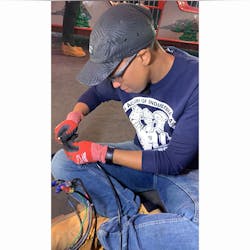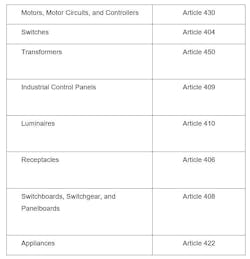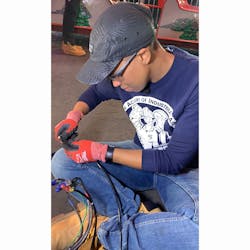The Apprentice’s Guide to NEC Chapter 4
Chapter 4 of the National Electrical Code [Equipment for General Use] contains all of the installation guidelines for everyday stuff or equipment that controls or consumes electricity. As an electrician, these are items you see throughout your daily routine no matter what sector of the industry you work in (e.g., residential, commercial, or industrial). This is the basic electrical equipment that can be found in residential houses (i.e., dwelling units), commercial buildings (i.e., special occupancies), and industrial facilities.
You could also classify Chapter 4 as the “repair stage” chapter of the NEC as it also offers guidance in replacing and repairing damaged or obsolete electrical equipment. But remember, the NEC is not intended to be a design manual for untrained persons. Practical field experience and training are required to understand most of these requirements.
The Table below lists a few of the articles in Chapter 4.
For this column, we’re going to focus our discussion on Art. 430.
Article 430 [Motor, Motor Circuits, and Controllers] is one of the most intimidating and largest articles in the NEC. Even if you have very little experience installing basic single-phase or three-phase motors, this article is structured in a way that’s easy to navigate (especially for newbies).
At the very beginning of Art. 430, you’ll find an illustrated directory of a complete motor circuit. This directory will steer you to the specific installation guidelines for each part of the motor circuit. This handy guide will save you time and the need to call the boss when searching for specific motor installation guidelines.
Here is a typical licensing examination question based on information from Chapter 4. Typically, an exam will have motor questions based on one of the following subject areas of a motor circuit:
- Motor feeders
- Motor controllers
- Motor thermal protection
- Branch circuit conductors
- Motor overload protection
- Short circuit and ground fault protection
Question: Branch-circuit conductors that serve a three-phase 240V, 15-hp induction-type motor shall have an allowable ampacity of at least ________ amperes.
A. 42.0
B. 46.2
C. 52.5
D. 60.5
Answer: This is a branch-circuit conductor question. Exam motor questions can range from one step to five steps to come up with the answer. This is a fairly easy three-step question. Before you attempt to answer any type of motor question, always identify what type of question it is — in other words, which part of the motor circuit are they asking about?
The directory in Figure 430.1 will guide you to the right part or section. If you look at the top and center point of Figure 430.1, it will guide you.
In this example, you should focus on:
- Motor Circuit Conductors, Sec. 430.21 through Sec. 430.29, Part II (top)
- Motor Circuit Conductors, Part II (center point)
Step 1. Find the motor current based on Table 430.250, not the motor nameplate rating. This table covers the full-load current for three-phase alternating-current motors, such as squirrel cage, induction-type, wound rotor (amperes).
Based on the motor characteristics in this sample question, the table lists our current draw as 42A. Be careful: This is just the first step in the process. The test creator listed this value as one of the answer options; but we are not finished yet. If you get the process mixed up, you’ll choose this answer by mistake.
Step 2. Find the guideline for sizing a branch-circuit conductor for a single motor. The directory points us to the part that covers branch-circuit conductors. Within seconds, you will find the instructions for sizing the branch-circuit conductor in Sec. 430.22 [Single Motor]:
“Conductors that supply a single motor used in a continuous duty application shall have an ampacity of not less than 125% of the motor full-load current rating.”
Step 3. Multiply the motor current from Step 1 (42A) by 125% [42A x 1.25 = 52.5A]. Therefore, the correct answer is (c) 52.5A.
Follow my column for more practical how-to articles and tips on electric basics and applying those concepts in the field (Everyday Instructions for Electricians, Introduction to Commercial Service Calculations, Introduction to Residential Service Calculations, and The Apprentice’s Guide to Non-Metallic Sheathed Cable). For more information on why a structured approach is so important to navigating the NEC and how to put its requirements into practice in real-world settings, read “The NEC for Newbies.”
Harold De Loach, a master electrician and electrical trainer/instructor, is the founder of The Academy of Industrial Arts (www.taia-school.com) in Philadelphia. With more than 30 years of experience in the field, he writes regular exclusive content for the E-Train and can be reached at [email protected].
About the Author
Harold De Loach
De Loach is the Director of Education and Training for the Leaders of Electrical License Preparation courses for Philadelphia and The Lehigh Valley (www.necprepclass.com). He is the founder and Director of The Academy of Industrial Arts L.L.C. (www.taia-school.com), a customized electrician training program that provides entry-level electrician training courses, electrical safety classes and customized electrical construction courses. He is trained by the National Center for Construction Education and Research (NCCER). He is a member of The National Society of Collegiate Scholars, the Independent Association of Electrical Inspectors, the Electrical Association of Philadelphia, and the Better Business Bureau.
His level of knowledge affords him to teach entry, intermediate, and master level electricians. Armed with more than 20 years of experience in the electrical, general construction, and real estate development industry, he offers his students and clients several unique skill sets. He has worked as the Head Craft Instructor and Assistant Director of Education at the Apprenticeship Training Center (affectionately known as The ABC School) in Harleysville Pennsylvania for Associated Builders and Contractors (The South-Eastern Pa. Chapter). Prior to Joining ABC, he directed a work-readiness (Re-Entry) Construction Technology program within The Philadelphia Prison System and as an Electrical Technician Program instructor at Kaplan Career Institute (Formerly Thompson institute) in Center City Philadelphia and Franklin Mills. He is available for consultation, private tutoring, speaking engagements, or strategic partnerships that can bolster the number of new electricians entering the industry.



